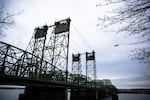As a joint committee of Washington and Oregon lawmakers considers the possibility of a new Interstate 5 bridge over the Columbia River, its members face a question: Whether to rely largely on in-depth and expensive analyses done more than a decade ago, or to inject new inquiries and issues in the discussion.
That choice was front and center on Wednesday when the committee met at Portland International Airport for the latest hearing in fresh talks over a new bridge. Over the course of two and a half hours, senators and representatives from both states were given a crash course in a host of sensitive and often competing, considerations.
Those included bridge height — which can impact ship traffic and flight patterns — historical sites near the bridge, marine wildlife, earthquake safety and design factors that affect the flow of vehicles over the bridge. Lawmakers did not take up whether a new bridge would include light rail or bus-only lanes, subjects that have drawn controversy in the past.
The meeting amounted to a highly abbreviated rundown of analyses that began in 2005 when officials in both states last seriously took up a replacement bridge. That process culminated in 2008, with a proposed design known as the “Columbia River Crossing.”
Related: The Present And Future Of Interstate 5
But the proposal blew up in 2013, when Washington lawmakers walked away from the $3 billion project amid outcry from critics on both sides of the river. By that point, Oregon had already approved its share of funding for the project.
Lawmakers in both states are now taking a fresh look at whether a new bridge is necessary and, if it is, what it should look like. And repeatedly on Wednesday, they wondered aloud how much of the former process they would seek to reinvent, and how much they would rely on past work.
“I want us all to think about the amount of work that was done and think about how many experts and people worked on this,” said Oregon state Rep. Susan McLain, D-Hillsboro. “For me, it’s about thinking about how do we utilize all that.”
While lawmakers have taken pains to say they are only discussing what a new bridge might look like, many in the room clearly believe that the century-old bridge needs to be upgraded.

The Interstate 5 bridge connecting Washington and Oregon across the Columbia River as seen from Vancouver, Washington, Saturday, Dec. 15, 2018.
Bradley W. Parks / OPB
“I think it’s pretty plain that the six problems that we identified previously have not gone away,” said Carley Francis, a regional administrator with the Washington State Department of Transportation, referring to issues like freight movement, traffic congestion, and seismic weaknesses in the current bridge.
“It’s pretty obvious that things haven’t gotten better,” said Oregon state Sen. Lee Beyer, D-Springfield, a chair of the joint committee.
But exactly what a project to replace or upgrade the bridge will look like appears to be up in the air. Lawmakers on Wednesday signaled a willingness to consider a wide range of ideas — and to introduce potentially new considerations, like improving air quality, into their criteria for a project.
“If the interest is to go back and re-solicit new ideas … that’s certainly a pathway,” Francis told the committee. “It may be that folks want to say, 'Some of this stuff is reusable as is.’ That’s a choice.”
As they developed the former Columbia River Crossing project, officials eliminated ideas like tunnels under the river or new bridges east or west of Portland, reasoning that they would not solve problems on I-5. The interstate currently sees 11 hours of congestion a day around the bridge, according to WSDOT.
The proposal they wound up putting forward the last time would have completely replaced the two spans that currently make up the Interstate Bridge, offering a higher arc so that ships could pass underneath without needing to lift the bridge.
Time will tell whether they arrive at similar conclusions in the current effort, but lawmakers are also acting with some urgency. As things currently stand, the states have five years to make substantial progress on a bridge, or pay back roughly $140 million in federal funds from the last failed attempt.
